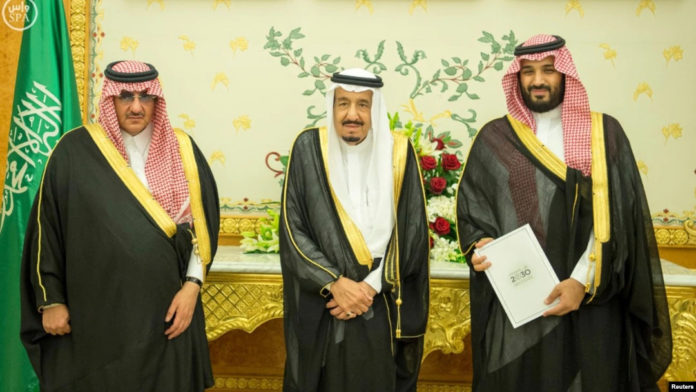Most recently, Saudi deputy crown prince Mohammed bin Salman announced Saudi Arabia’s National Transformation Plan (NTP) in which Vision 2030 maintained a central position. It would radically transform the Kingdom’s economy. Vision 2030 sets out a comprehensive road map to promote more efficient government services and to diversify the Kingdom’s economy by boosting private sector job creation and developing the non-oil economy.
Lesser Dependency of Oil
It outlined the key elements to shift the kingdom’s economy away from its dependence on oil. It was meant to further diversifying its macro-economy. It further liberalized its national economy. It envisioned attracting more and more foreign direct investments in the different sectors of production and survival in the country. It encouraged boosting private sector in order to speed up business activities in the Kingdom.
Series of Comprehensive Reforms
It included regulatory, budget and policy short, medium and long terms reforms that will be implemented over the next 15 years in the hope of making the country less reliant on crude oil. It started new chapter in its economy which heavily dependent on “black gold” to new smarter economy. It aimed to build a “prosperous and sustainable economic future” for the country.
Vibrant Society
It supported to have a vibrant society. It emphasized on the rapid social development. It encouraged qualitative education, health and housing facilities to its countrymen. Indeed, it was a paradigm shift from the traditional sources of production to more innovative. It was the start of new era in the Kingdom.
Start of Smarter Economy
It outlined different rigorous reforms in the different sectors of its national economy. Now, it is the start of new chapter i.e. a smarter economy. Moreover, Saudi Arabia introduced a new $ 2 trillion mega fund to generate more new jobs, further diversification of economy, markets, services, financial derivatives, banking industry and the last but not the least, further gearing up of commercial diplomacy for achieving desired goals of socio-economic prosperity in ear of post-oil.
Privatization Drive
The NTP is the centerpiece of the “Vision 2030” reforms set out in the earlier part of this year. He planned to change the country’s public sector-dependent and promoted and fostered private sector entrepreneurial spirit.
The Vision 2030 initially focused to partly privatize the state oil company, Aramco, which dominates the Saudi economy so far. A small portion less than 5 per cent of the commercially “delineated” part of the company would be listed, probably in 2018. According to the plan, the ownership of Saudi Aramco will then be transferred to the state’s Public Investment Fund, which will help bolster it into a sovereign wealth fund valued at up to $3tn, the world’s largest, with a mandate to kick-start domestic investment.
Privatizing Government Assets
Privatizing government assets, from Saudi Aramco to other assets in healthcare and education, will help meet ambitious diversification targets of raising non-oil government revenue from SR163bn ($43bn) to SR1tn by 2030, and to boost the role of the private sector from 40 per cent to 65 per cent of gross domestic product by 2030 and that of small and medium-sized enterprises from 20 per cent to 35 per cent.
Labour Market Reforms
The Vision 2030 also includes the labour market reforms. It encourages further saudisation in the private sector. The Saudi government’s labour report last October 2015 showed that “saudisation” of the private sector is very slow going, with only about 15 per cent or 22 per cent of private-sector jobs held by Saudis. Public sector employees account for at least three times as many jobs as the private sector and the labour market report forecast that Saudis will need 2.2 million private sector jobs by 2025 to reach full employment.
High Employment Ratios
It also aims to reduce unemployment from 11.6 per cent to 7 per cent by 2030. It is seen as essential to end the Kingdom’s reliance on lower-paid foreign labor. It means a renewed focus on education, as well as a higher female participation in the workforce (from 22 per cent to 30 per cent).
More than half of the population is under 25, many younger Saudis hope that economic transformation will lead to a less stifling and a more equitable society. And job creation is rightly seen as a progressive tool in averting disaffection.
Befitting Change in Education System
Its another key step for reform is the drastic change in the education system. Now it will focus more on the skills needed for a modern economy. Institutionalization of technical education, knowledge based economy and promotion of higher education will be achieved through rigorous reforms announced in the NTP.
Main Themes of Vision 2030
Vision 2030 is the “way forward” for the Kingdom of Saudi Arabia. It definitely provides the essential elements for survival i.e. stability and sustainability in the fields of national economy, society, civility, governance and the last but not the least, social development.
It is based on three main themes which are given below in a diagram.
Diversification of National Economy
According to above diagram the economic theme puts clear guidelines on the methodology to diversify the economy away from oil, and reducing the reliance on government spending as the main source for growth. According to this theme, through a combination of initiatives, including investment, privatization, and public-private partnerships, the Kingdom will be able to develop entirely new economic sectors. Broader goals that will ensure a thriving economy include raising the share of non-oil private sector GDP from 40 percent to 65 percent.
It also includes an ambitious target of increasing the Kingdom’s ranking, in terms of GDP size, from 19th to be among the top 15 countries in the world.
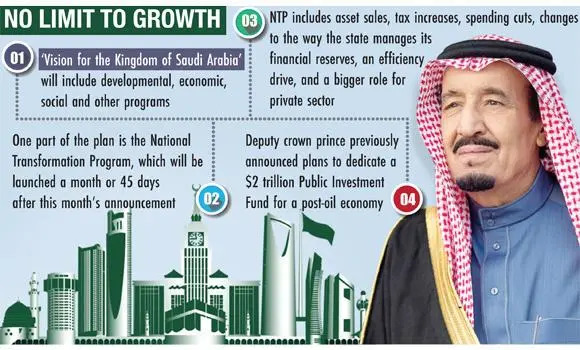
A Paradigm Shift Away From Oil
The Vision 2030 highlighted that the country would raise its share of non-oil exports in non-oil gross domestic product (GDP) from 16 percent to 50 percent till 2030. It geared up further privatization in the country along with creation of the “largest sovereign wealth fund” in the world. Sovereign wealth fund could top $2 trillion and would be linked to its vast revenues from oil. It would smooth the process of listing private Saudi companies and state-owned enterprises, including Aramco. It would require deepening liquidity in its money markets, fortifying the role of the debt market and paving the way for the derivatives market.
Localizing Renewable Energy and Industrial Production Channels
The planned economic diversification also involved localizing renewable energy and industrial equipment sectors and creating high-quality tourism attractions. It also plans to make it easier to apply for visas and hoped to create 90,000 job opportunities in its mining sector.
New Era of Digital Infrastructure
The vision 2030 also included announcements in digital infrastructure, culture, education and the military. Prince Mohammed confident, that Saudi Arabia could achieve its vision 2030 with oil at just $30 a barrel.
Further Women Empowerment
One of the salient features of its vision 2030 is further empowerment of women in the society. It would further increase women workforce i.e. from 22 percent to 30 percent. It would lower the rate of unemployment from 11.6 percent to 7 percent.
“With over 50 percent of our university graduates being female, we will continue to develop their talents, invest in their productive capabilities and enable them to strengthen their future and contribute to the development of our society and economy,”
Promoting Public–Private Partnership
Promoting public–private partnership would remain the cornerstone of vision 2030. In order to generate the finances/resources and to diversify the macro-economy away from oil on a permanent footing a number of very interesting and bold initiatives have been envisaged under NTP.
Modernization of Tourism Industry/Facilities
Tourism is one of the main sectors under the NTP. Now more focus would be on promoting religious tourism on scientific grounds in the Kingdom. According to Kingdom’s national figures, there are eight million people visit to Saudi Arabia for Umrah every year. As per the plan, in 2020, some 15 million people will visit to Saudi Arabia for Umrah, and by 2030, this number is projected to hit 30 million.
The new Jeddah Airport will serve this vision in a very big way, Al-Taif Airport will also serve this vision in a very big way as it will receive large numbers, and accommodate these numbers. The infrastructure of Makkah is strong. Haramain Train will support these figures. Now, we are trying to finish the Makkah Metro as soon as possible,”
Saudi Arabia also plans to widely open its door for tourism for all nationalities, indeed, “in accordance with our values and beliefs. It would generate additional income for the country too. From Umrah and Haj, the Kingdom could generate revenues of over SR200 billion ($53b) by the year 2020.
Friendly Taxation
According to Vision 2030, the Kingdom plans to broaden the non-oil revenue a plan to tax the wealthy is also on cards. As per the ‘Vision 2030,’ Riyadh now planned to generate at least an additional $30 billion from subsidy reform and another $10 billion from value added tax.
Incentives for Expatriate Communities
‘Vision 2030’ would revolutionize labour market and force especially the expatriate community living in the Kingdom. It wants to capitalize on this funding source by giving long-term residency rights to expats living in the Kingdom for a considerable period of time and by allowing them to legally invest in the country and buy property. The permanent residence, or “green card”, system in the Kingdom will generate around $10 billion annually through reduced remittances and other sources, besides bringing in billions of dollars in foreign investment.
Property Rights
Vision 2030 will abolish the existing sponsorship system for holders, who will be required to pay zakat and value-added tax, if any, besides premiums on insurance, etc. The plan, to be implemented over the next five years, would permit the long-term expats to own property and undertake commercial, industrial and related activities. It is hoped that the Vision 2030 will generate at least $10 billion in revenues annually.
Thriving Economy
Vision 2030 outlines a path that the Kingdom will take in order to build a thriving country and economy, setting out long-term goals and expectations. It highlights how Saudi Arabia’s key strengths and capabilities can be turned into enabling tools to help transform Saudi Arabia over the next 15 years. It sees the Kingdom’s religious and cultural heritage, investment prowess, and locational advantage playing a vital role in moving the economy forward.
Saudi Arabia witnesses the extraordinary expansionary cycle in its macro-economy over the last 10 years due to which the economy is now among the largest in the world, it remains reliant on government spending and subsidies. Between 2005 and 2015, current expenditure, government spending increased significantly from SR284 billion to SR673 billion. But spending is still mainly financed by oil revenues. Over the past five years, 87 percent of the annual share of government revenues has come from oil. Vision 2030 would gradually reduce oil share of GDP in the days to come. It would further strengthen its macro-economy through diversification drive in the days to come.
New Subsides Criteria
The Vision also seeks to set clear subsidy criteria, including on fuel, food, water, and electricity, in order to create a more equitable distribution. It will significantly improve the fiscal balance. To help achieve the Vision, several major transformative and executive programs have been identified, some of which have already been underway, while others were announced for the first time.
Three Core Strengths
According to Vision 2030 the new economy will be built on three core strengths: Kingdom and Islamic leadership; the country’s strategic geographic location as a hub connecting Asia, Africa and Europe; and vast natural resources, including uranium, gold, silver, aluminum, iron and phosphate, in addition to oil and gas.
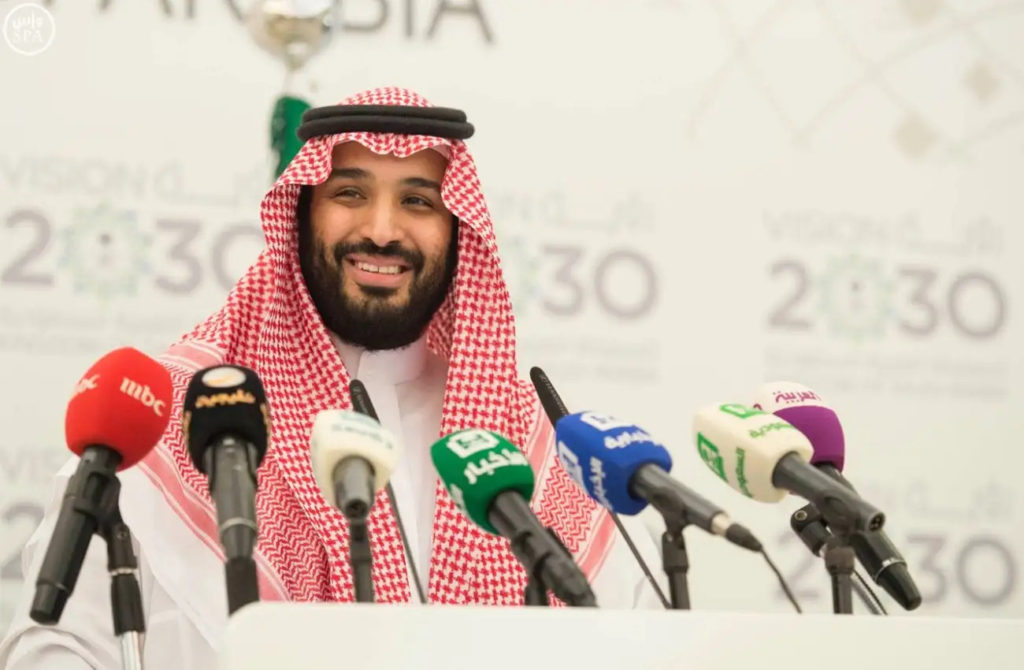
Comprehensive Program
Saudi Arabia’s Vision 2030 is a comprehensive program which seeks to transform the entire state into a new country that ranks high among the developed nations. It does not limit to economic growth. Rather it also includes social, humanitarian, developmental, military, and performance aspects.
The vision focuses on transparency and good governance, and eliminating leniency or tolerance for corruption at any level. It speaks directly about corruption and this is the first step to fighting it.
Wise Decision Making
The vision also speaks of detailed reviews of all government structures and procedures so as to ensure clear separation between the decision-making process, the implementation, and the monitoring of such implementation and performance. It is very important as it guarantees transparency in monitoring performance and achieving results.
Important Role of King Abdullah Port
The further development of King Abdullah Port has special sway in its vision 2030. It would further revolutionize its aviation industry in the days to come. In many areas of the world, ports have helped build cities and economies. Ports of Hong Kong, Singapore, Shanghai, Dubai and New York have played substantial role in their economies. King Abdullah Port is pivotal to the King Abdullah Economic City, subsequently contributing to the overall economy of Saudi Arabia.
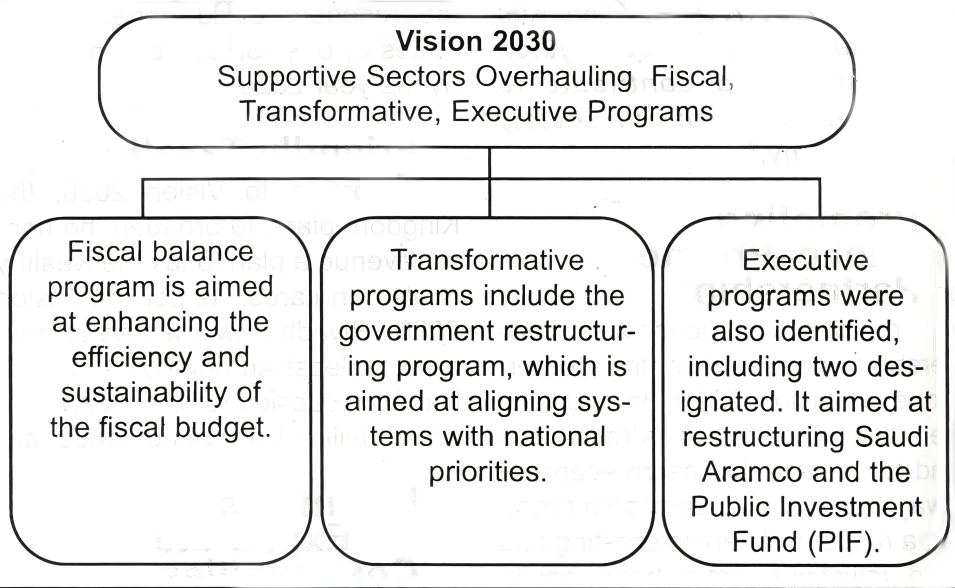
Concluding Remarks
The Kingdom of Saudi Arabia is passing through difficult times of its survival due to emerging socio-economic, geo-political and geo-strategic trends in and beyond the region. But thanks Allah Almighty, it has strategic vision about economy, governance, civility and military due to which, its macro-economy would be stronger, stabilizer and sustained in the days to come. Credit must goes to its visionary leadership head by King Salman bin Abdulaziz.
Vision 2030 is a paradigm shift. It encourages having more and more renewables through its national drive of further diversification of economy and resources. It upholds the traditions of transparency, accountability, liberalization, privatization and the last but not the least, openness of its every aspects of its national life.
It promotes non-oil sectors of the economy. It reduces oil share of GDP so that its macro-economy would be more stable and sustained. It encourages women empowerment in every field. It would be pro-development. It would be pro-commercial diplomacy. It would create so many new jobs in the country.
It creates a successful partnership between private sector investors and the government will be the critical factor in shaping Saudi Arabia’s development over the coming five years. It would increase the private sector’s contribution to GDP from 40 percent today to 65 percent by 2030, and growing non-oil government revenues from SR163 billion ($43 billion) to SR1 trillion ($267 billion) by the end of the next decade.
It is hoped that the Vision 2030 will transform the business activities in the country the government’s priorities and the strategies of businesses seeking to take advantage of the new opportunities being created in the kingdom.
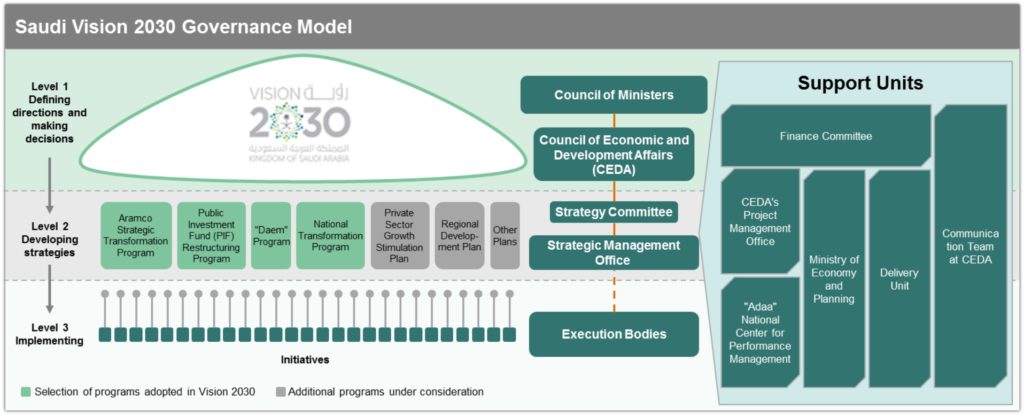
Public-private partnership would be an effective tool to mitigate the collapse in oil prices. Saudi Arabia is now institutionalizing public-private partnerships (PPP) for its most important mega infrastructure projects. News roads, rails, ports and airport projects have already been initiated under PPP. According to its national reports, Saudi Arabia needs to install nearly 48GW new electricity generation capacity by 2024 in order to meet demand, which is growing by 7 percent a years. It will take the same approach (PPP) to deliver the estimated $25 billion of planned water and wastewater projects over the next five years.
Its “State” has been solo actor of its rapid socio-economic development and prosperity for so many years, which is has now been replaced/reallocated to PPP. It will be painful in the short term but definitely deliver its dividends in the days to come.
The Vision 2030 presents series of comprehensive reforms which enhances of hope achieving desired goals of socio-economic development. Its systematic implementation would make the difference.
Development is a collective effort on parts of every sector of macro-economy (traditional & non-traditional) and segment of the society in order to achieve the desired targets. It stands for collective national drive consists of the participation of universities, research centers, and religious, social, media and educational institutions. Public and civil societies must join hands in administering research projects, workshops, conventions and public awareness campaigns. It would transform Saudi’s economy into smarter economy, more competitive and knowledge based in the days to come.

Gulf Cooperation Council (GCC) has many visions. UAE strategic vision 2020 has already produced miracles in every sphere of life. Qatar, Kuwait and other GCC countries also have their strategic visions, changing crises into opportunities. At world level, strategic visions have produced drastic change. In this regard, Singapore is the prime example which begun with the vision of its leader who transformed a small island into a highly successful economy as well as a global commercial center. Its leader Lee Kuan Yew focused on real assets i.e. human resources and geared up social development in the country which is now paying its dividends. Malaysian leader Mahathir Mohamad, spearheaded its transformation and believed in the power of initiative to bring about change.
Saudi Arabian Vision 2030 is a futuristic in nature. It is hope of better life. It is the promise of new chapter in socio-economic development. It is the pledge of changing crises into opportunities. It is vision of overall development. It is blueprint of economic growth. It is plan of attracting more and more inflows of FDIs. It is the system of having joint ventures in the different sectors of economy and production. It is the plan of initiating different mega projects under the umbrella of public-private partnership. It is the drive to introduce series of reforms in order to make this country and its economy strong and stable despite the emerging socio-economic, geo-political and geo-strategic trends in the region.
It is the mega program of human resource management which will create unlimited new jobs. It would enhance its national drive of ”Saudization”. It is a method of promoting technical and higher education in the country.
Vision 2030 is all about “Change” but Saudi Arabia does not need to achieve a negative change. Because, during the pursuits of high socio-economic prosperity, alternatives/ renewables, banking & financial system, higher education, resultant is the drastic change and national/ social values, local culture, heritage and even religious norms are under serious threat. Many success stories of so many countries of Africa, Latina America and Asia highlight “marginalization of local culture, social values and “compromise on rituals and religion. The leadership of Saudi Arabia must take extra care to these essential elements of national pride, society, religion and above all integrity in the hot pursuits of higher economic development. The principles of tolerance and moderation provide an ideal combination to fight against extremism and radicalization in the country.
Vision 2030 is based on moderation, tolerance, perfection, discipline, justice, and transparency. These are important actors for the next stage as the vision seeks to achieve a productive society rather than a consuming one. The principles of tolerance and moderation are a cure for many social phenomena that arise from those whose aim is to spread extremism and radicalization.
Deputy Crown Prince Mohammed bin Salman is the architect of Vision 2030. It consists of expectations and aspirations carry high hopes for future Saudi generations. To achieve this goal, the Kingdom of Saudi Arabia must bring much needed overhauling in its regulations and policies. It would bring true development and modernization. It also needs a modern and flexible legislation, and this is the key that must be in place for the implementation of new initiatives.
There is an urgent need to introduce new codes of corporate governance in the banking and finance industry and money, debt markets. Vision 2030 has already incorporated a program to measure performance, the National Center for Performance Measurement of Public Institutions which is right step in right direction. Indicators and regulations to measure performance have been produced with the goal of increasing accountability and transparency which is the essence of Vision 2030 and its series of reforms.
Vision 2030 is also meant for the further strengthening of governance of government affairs and establishes clearly defined terms of reference that allow for flexibility and accountability. An office for strategic management will be set up at the Council of Economic and Developmental Affairs and will work on preventing duplications or inconsistencies. A center will also support decision-making at the Royal Court and provide information and necessary data to support decision-making processes. It is hoped that all these reforms and institutions will enhance traditions of accountability, transparency, fair-play and openness in order to achieve desired goals of socio-economic development in the days to come.
To sum-up Vision 2030 is the total sum of its indigenous wisdom and not a borrowed idea, policy and program. It is based on its industrious traditions and not on foreign consultancy. It is the true reflection of its strong political will to transform crises into opportunities. It is the symbol of gradual transformation befitting to its social values, culture, heritage, religion and governance.
It is the desire of its rulers to institutionalize spirits of transparency, accountability and separation of powers. It is indeed a national drive of qualitative life and quantitative opportunities. It is the dream of its common people to live a productive, collaborative and decent life.
It is about boosting tourism and shunning of terrorism and extremism. It is development oriented. It is also export oriented. Hopefully, the Kingdom of Saudi Arabia will achieve all goals of socio-economic development in the future as mentioned in its strategic Vision 2030.


